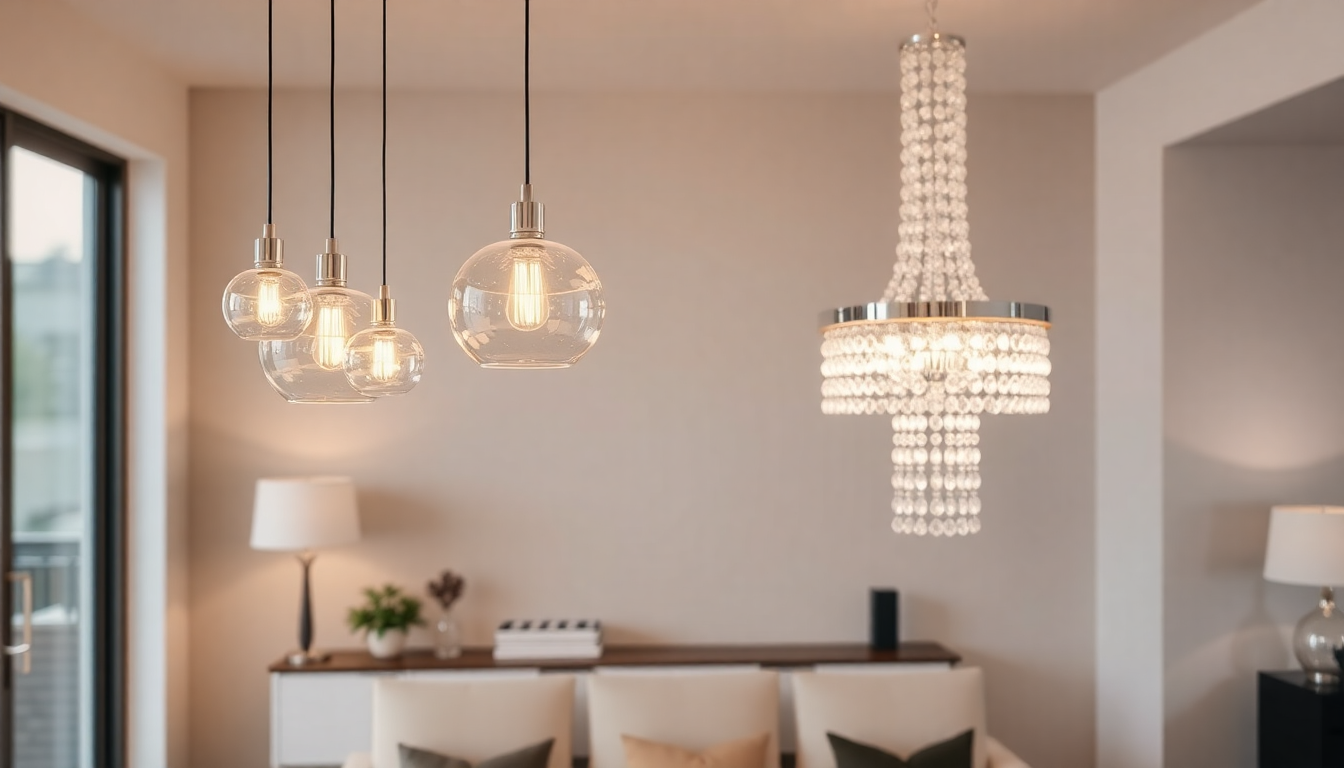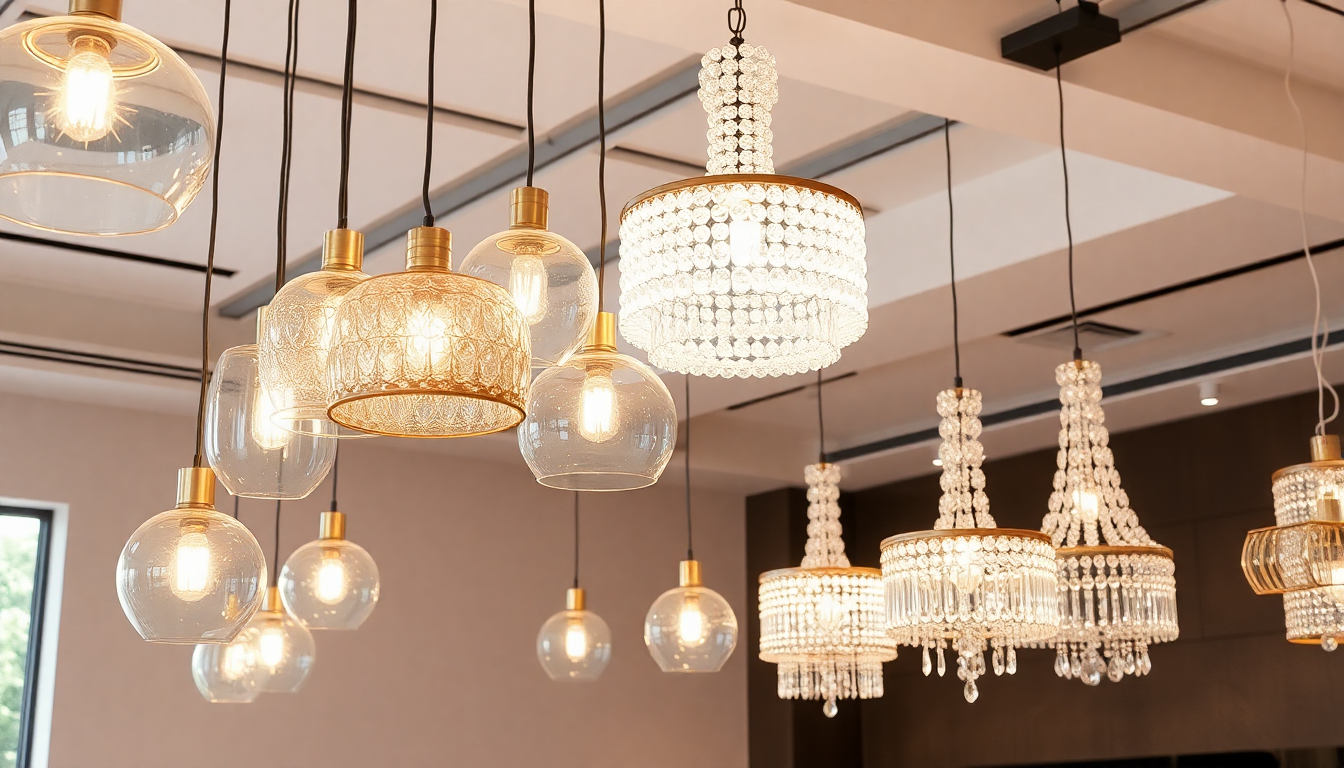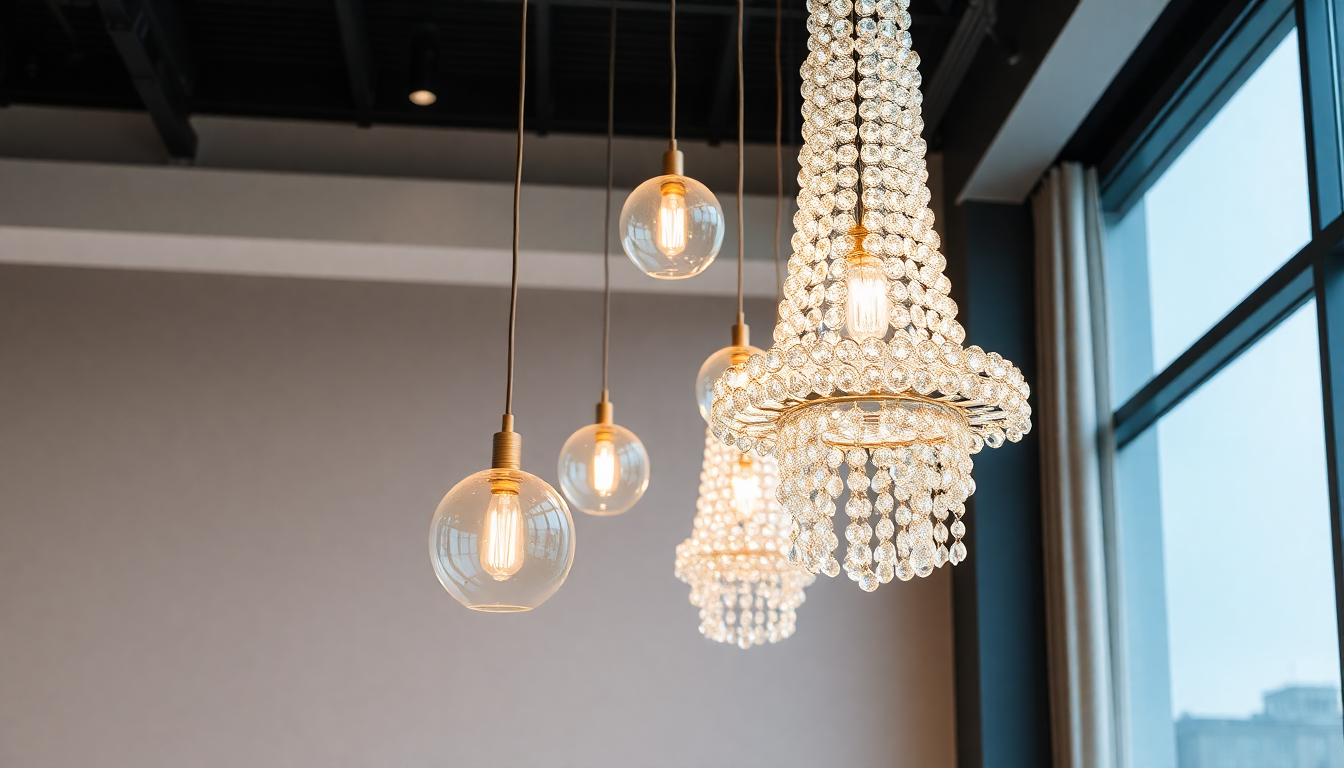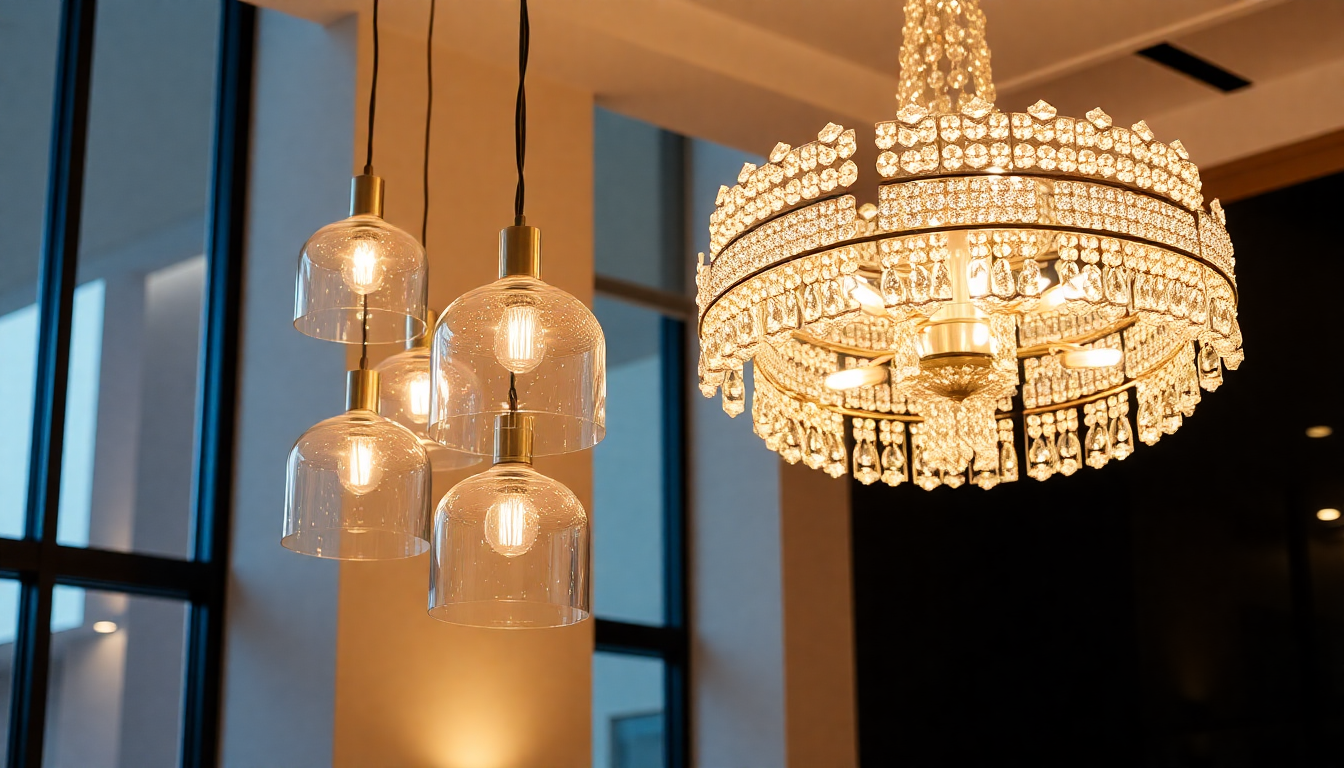Introduction
Glass pendant lighting can transform a room—adding task light, ambiance, texture and visual drama. Whether you prefer the crisp sparkle of clear glass pendant lights, the soft diffusion of frosted and milk glass, the color and craft of stained glass pendants, or the organic artistry of blown glass pendant lights, each choice affects light quality, mood, and style. Layer those with crystal chandeliers and you get depth and luxury that reads expensive and intentional.
Quick Summary: Which Glass Pendant Should You Choose?
- Clear glass pendant lights for maximum sparkle and direct task light.
- Frosted / milk glass pendant lighting for even ambient glow and glare control.
- Stained glass pendant light when color, pattern, and vintage character are desired.
- Blown glass pendant lights for bespoke shapes, artisan appeal, and subtle color plays.
- Combine with crystal chandeliers to create layered, luxurious lighting scenes—use chandeliers as anchors and pendants for function and accent.
Deep Dive: Glass Types Explained
Understanding materials and how they interact with light is the first step to choosing the right fixture.
Clear Glass Pendant Lights
- Light behavior: Maximizes brightness, defines shadows, and highlights bulb filaments. Ideal for task zones like kitchen islands and bars.
- Styling: Works with industrial, modern, and minimalist interiors. Clear glass amplifies reflective surfaces (marble, stainless, chrome).
- Bulb choices: Decorative filament LEDs, globe LEDs, or higher-CRI warm-white LEDs for flattering skin tones.
Frosted & Milk Glass Pendant Lighting
- Light behavior: Diffuses and softens light, minimizing hotspots and harsh shadows. Milk glass is an opaque white variant that reads warm and timeless.
- Styling: Perfect for Scandinavian, mid-century, traditional, and modern farmhouse looks.
- Function: Great for ambient lighting, bedrooms, and dining areas where even illumination is preferred.
Stained Glass Pendant Light
- Light behavior: Filters light through colored panels, creating mood and color accents in a room.
- Styling: Ideal for period homes, eclectic interiors, and accent pieces that double as art.
- Care: Often heavier and more delicate—requires secure installation and occasional cleaning of lead or metal cames.
Blown Glass Pendant Lights
- Light behavior: Can be clear, translucent, or colored—often features subtle gradients, bubbles, and organic forms.
- Styling: Handblown fixtures lend a bespoke, gallery-quality presence. They work well in modern, artisan, and luxury interiors.
- Variation: Expect slight irregularities; these are desirable and part of the artisan character.
Crystal Chandeliers: How They Complement Glass Pendants
Crystal chandeliers bring refractive sparkle and an unmistakable sense of luxury. Use them as room anchors while deploying glass pendant lighting for zones and tasks.
- Role: Chandeliers create focal glow and broad ambient light; pendants fill in task zones and circulation lighting.
- Balance: Avoid visual competition—if the chandelier is ornate, choose simpler pendant shapes and finishes.
- Finish coordination: Match or complement metal finishes (brass, chrome, bronze) between pendants and chandelier hardware for cohesion.
Choosing by Room and Function
Different rooms demand different light qualities. Heres a practical breakdown by use case.
Kitchen
- Task: Clear or blown glass pendant lights in a linear arrangement over islands provide focused illumination for prep and cooking.
- Ambient: Combine with recessed cans or a dimmable chandelier in an adjacent dining zone.
- Tip: Place pendants 28 –34 inches above the countertop (measured from countertop to bottom of fixture).
Dining Room
- Focal: Use a crystal chandelier centered over the table as an anchor. For added function, add milk glass pendant lighting in adjacent zones (buffet, bar).
- Style: If the chandelier is modern and minimal, introduce a cluster of blown glass pendants for contrast.
- Height: Hang the chandelier so the bottom is roughly 30 –36 inches above a standard 30-inch dining table (adjust for ceiling height).
Living Room
- Layering: Combine ambient chandelier light with clear glass pendants as reading lights or milk glass pendants for soft accents.
- Zoning: Use pendants to define conversation areas or a console table while the chandelier lights the whole room.
Bedroom
- Comfort: Milk glass pendant lights or frosted glass pendants create flattering, calm diffusion for restful spaces.
- Flanking: Replace bedside lamps with pendants to free up nightstand surfaces—keep them dimmable.
Foyer & Stairwell
- Statement: A blown glass pendant or a cascading series of blown glass pendants makes an architectural statement in double-height spaces.
- Chandelier pairing: A mid-size crystal chandelier in the foyer can be the centerpiece—complement with glass pendants in adjacent hallways for continuity.
Mixing & Matching: Rules and Creative Approaches
Mixing pendants and chandeliers is about balance: scale, finish, color, and intensity.
- Scale first: Ensure pendants are proportionate to furniture and room size. A tiny pendant wont be visible in a 15-foot high foyer.
- Finish coordination: Tie metals together—use warm brass chandelier with warm brass pendant canopies or use a neutral matte black with clear glass for contrast.
- Color temperature consistency: Use bulbs with the same Kelvin rating throughout a zone (e.g., 2700K for warm ambient rooms, 3000K for kitchens).
- Rhythm & repetition: Use repetition of shape, material or finish to unify mixed elements—for example, clear globes over an island with a crystal chandelier that has similar round crystals.
- Varying heights: Group pendants at staggered heights for sculptural clusters; ensure functional pendants are at task height.
Technical Considerations: Bulbs, Dimmers, and Controls
- LEDs: Prefer LED bulbs for efficiency and long life. Choose high-CRI (90+) LEDs for color-critical areas like kitchens and dining.
- Color temperature: 2700K for warm, traditional spaces; 3000K for balanced warm-white; 3500K for brighter, more modern kitchens.
- Dimming: Use compatible LED dimmers; many LED bulbs require triac or ELV dimmers. Smart dimmers add scene setting and schedules.
- Smart bulbs: Allow tunable white (2700K –3000K) and color control to adapt mood without rewiring fixtures.
Sizing & Placement Guide (Formulas and Examples)
- Room width + length (in feet) = total feet; add as inches to determine chandelier diameter (e.g., 12 x10 ft room = 22 inches chandelier diameter).
- Over islands: linear group of pendants spaced 24 –30 inches apart center-to-center for even coverage.
- Ceiling height: For each extra foot of ceiling above 8 ft, add 3 –4 inches to the recommended hanging height.
Installation & Safety Checklist
- Confirm ceiling electrical box rating supports fixture weight (especially for heavy blown glass or crystal chandeliers).
- Turn off circuit power during installation; consider hiring a licensed electrician for rewiring or high-weight fixtures.
- Use proper anchors for plaster or drywall ceilings and follow the manufacturers mounting instructions.
- Check UL/ETL listings if safety and code compliance are priorities.
Maintenance, Cleaning & Care
- Clear glass pendants: Wipe with microfiber and streak-free cleaner; remove and clean bulbs periodically to maintain sparkle.
- Frosted/milk glass: Use mild soap and water; avoid abrasive cleaners that can remove factory finish.
- Stained glass: Dust gently; use a soft cloth with distilled water. Inspect lead cames for wear.
- Blown glass: Clean with soft cloths; for clusters, consider professional cleaning for hard-to-reach fixtures.
- Crystal chandeliers: Clean crystals with approved cleaners or remove crystals and soak in warm water and mild detergent if heavily soiled.
Budget Considerations & Cost Ranges (2025)
- Entry-level clear glass pendants: $60 –$200 each.
- Mid-range milk/frosted glass pendants: $120 –$400 each.
- Handblown glass pendant lights: $250 –$1,200+ depending on artisan and finish.
- Stained glass pendant light (Tiffany-style): $200 –$1,500 depending on complexity.
- Crystal chandeliers: $400 –$5,000+ depending on size, crystal quality, and brand.
Case Studies: Three Real-World Styling Scenarios
Case Study 1: Contemporary Kitchen with Island (Clear + Crystal)
Challenge: Bright task lighting thats also elegant for entertaining.
- Solution: Three clear glass pendant lights in a linear arrangement over the island (3000K LEDs, 1,000 lumens each). A small crystal chandelier over the adjacent dining table anchors the zone. Metal finishes in brushed nickel tie the two areas together.
- Products: Clear Glass Pendant — Modern Globe (
 ) and Crystal Chandelier — Small Classic (
) and Crystal Chandelier — Small Classic ( )
)
Case Study 2: Cozy Dining Room (Milk Glass + Mini Chandelier)
Challenge: Soft, flattering light for intimate dinners.
- Solution: Use a milk glass pendant light cluster above the sideboard and a compact crystal chandelier centered above the table. Dim the chandelier to 40% when dining.
- Products: Milk Glass Pendant Light — Opaque Dome (
 ) and Crystal Chandelier — Mini Sparkle (
) and Crystal Chandelier — Mini Sparkle ( )
)
Case Study 3: Foyer with Vertical Drama (Blown Glass Cascade)
Challenge: Make a strong first impression in a two-story foyer.
- Solution: A cascade of blown glass pendant lights hung at varying heights creates movement and reflects light into the stairwell. Complement with recessed uplighting for subtle wash on walls.
- Products: Blown Glass Pendant Lights — Handblown Cluster (
 )
)
SEO Tips for Product Pages & Blog Content (to Rank for Glass Pendants in 2025)
- Include primary keywords in the page title and H1: "glass pendant lights" or "glass pendant lighting."
- Use descriptive alt text for product images that includes keywords: e.g., "clear glass pendant lights over kitchen island."
- Write unique product descriptions emphasizing light quality and use cases: "This milk glass pendant light creates a soft ambient glow ideal for bedrooms and dining areas."
- Create buying guides and long-form content (like this article) that target long-tail keywords such as "how to mix blown glass pendant lights with crystal chandelier" or "best milk glass pendant light for bedside."
- Use structured data (schema.org/Product) to surface pricing, availability, reviews, and images in rich results.
- Internal linking: Link from category pages (glass pendant lighting) to individual product pages, and from blogs to recommended product listings.
Frequently Asked Questions (FAQs)
Are clear glass pendants too bright?
Clear glass tends to amplify bulb brightness. Use lower lumen LED bulbs or add a shade/liner if needed. Decorative filament LEDs offer style while controlling glare when positioned correctly.
Can I mix frosted and clear pendants in the same room?
Yes—mixing works if you maintain consistent finishes, bulb color temperature, and proportional scale. Consider clear pendants for task areas and frosted/milk for ambient zones.
How do I care for a stained glass pendant light?
Dust regularly, use a soft cloth and mild cleaner for glass surfaces, and inspect metal cames for corrosion. For leaded pieces, avoid harsh chemicals and seek restoration services if cracks develop.
Do blown glass pendant lights need special mounting due to weight?
Some blown glass fixtures are heavier—confirm the mounting bracket and ceiling junction box are rated for the fixtures weight. Use an electrician if unsure.
Final Styling Checklist
- Decide primary function: task, ambient, decorative.
- Choose glass type based on light quality desired: clear for sparkle, frosted/milk for diffusion, stained for color, blown for craft.
- Match metal finishes and bulb color temperature across the zone.
- Consider scale, spacing, and dimming options before installation.
- Use a crystal chandelier as an anchor and glass pendants for zones and tasks.
Where to Buy: Product Examples & Images
Below are representative product links. Replace these example links with your actual product URLs and images for customers to shop directly.
-
Clear Glass Pendant — Modern Globe (glass pendant lights)

-
Clear Glass Pendant Lighting — Row Set

-
Milk Glass Pendant Light — Opaque Dome (milk glass pendant light)

-
Stained Glass Pendant Light — Tiffany-Style (stained glass pendant light)

-
Blown Glass Pendant Lights — Handblown Cluster (blown glass pendant lights)

-
Crystal Chandelier — Classic Sparkle (crystal chandelier)

Conclusion & Next Steps
Choosing between clear vs frosted glass pendant lights is about desired light quality: clarity and sparkle versus softness and diffusion. Stained and blown glass introduce color and craft, while crystal chandeliers add glamour and depth. Thoughtful combinations—guided by scale, finish, and bulb choice—produce layered, high-end results.
If you like, I can: provide a tailored lighting plan for a specific room, suggest exact product pairings from your catalogue, or mock up layout options with dimensions and pendants spaced to scale. Share your room photos, dimensions, ceiling height and style preferences and Il draft a custom recommendation using your glass pendant lighting and crystal chandelier products.




